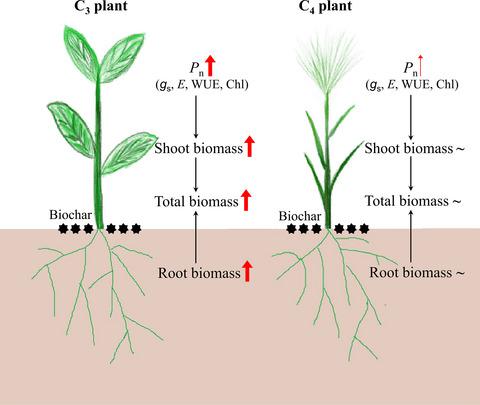当前位置:
X-MOL 学术
›
GCB Bioenergy
›
论文详情
Our official English website, www.x-mol.net, welcomes your feedback! (Note: you will need to create a separate account there.)
Biochar amendment boosts photosynthesis and biomass in C3 but not C4 plants: A global synthesis
Global Change Biology Bioenergy ( IF 5.6 ) Pub Date : 2020-07-06 , DOI: 10.1111/gcbb.12720 Yanghui He 1 , Yixian Yao 1 , Yuhuang Ji 1 , Jun Deng 2 , Guiyao Zhou 1 , Ruiqiang Liu 1 , Junjiong Shao 1 , Lingyan Zhou 1 , Na Li 1 , Xuhui Zhou 1, 3 , Shahla Hosseini Bai 4
Global Change Biology Bioenergy ( IF 5.6 ) Pub Date : 2020-07-06 , DOI: 10.1111/gcbb.12720 Yanghui He 1 , Yixian Yao 1 , Yuhuang Ji 1 , Jun Deng 2 , Guiyao Zhou 1 , Ruiqiang Liu 1 , Junjiong Shao 1 , Lingyan Zhou 1 , Na Li 1 , Xuhui Zhou 1, 3 , Shahla Hosseini Bai 4
Affiliation

|
Biochar is a carbon (C)‐rich solid produced from the thermochemical pyrolysis of biomass. Its amendment to soils has been proposed as a promising mean to mitigate greenhouse gas emissions and simultaneously benefit agricultural crops. However, how biochar amendment affects plant photosynthesis and growth remains unclear, especially on a global scale. In this study, we conducted a global synthesis of 74 publications with 347 paired comparisons to acquire an overall tendency of plant photosynthesis and growth following biochar amendment. Overall, we found that biochar amendment significantly increased photosynthetic rate by 27.1%, and improved stomatal conductance, transpiration rate, water use efficiency, and chlorophyll concentration by 19.6%, 26.9%, 26.8%, and 16.1%, respectively. Meanwhile, plant total biomass, shoot biomass, and root biomass increased by 25.4%, 22.1%, and 34.4%, respectively. Interestingly, plant types (C3 and C4 plants) showed greater control over plant photosynthesis and biomass than a broad suite of soil and biochar factors. Biochar amendment largely boosted photosynthesis and biomass on C3 plants, but had a limited effect on C4 plants. Our results highlight the importance of the differential response of plant types to biochar amendment with respect to plant growth and photosynthesis, providing a scientific foundation for making reasonable strategies towards an extensive application of biochar for agricultural production management.
中文翻译:

生物炭改良剂可促进C3植物而非C4植物的光合作用和生物量:全球合成
生物炭是通过生物质的热化学热解产生的富含碳(C)的固体。有人提议对土壤进行修正,这是减轻温室气体排放并同时使农作物受益的有希望的手段。然而,尚不清楚生物炭修正如何影响植物的光合作用和生长,尤其是在全球范围内。在这项研究中,我们进行了74种出版物的全球综合分析,并进行了347对配对比较,以获取生物炭改良后植物光合作用和生长的总体趋势。总体而言,我们发现生物炭改良剂显着提高了光合速率27.1%,并使气孔导度,蒸腾速率,水分利用效率和叶绿素浓度分别提高了19.6%,26.9%,26.8%和16.1%。同时,植物总生物量,芽生物量,和根生物量分别增加了25.4%,22.1%和34.4%。有趣的是,植物类型(C3和C 4植物)对植物的光合作用和生物量的控制能力要强于一系列土壤和生物炭因子。生物炭改良剂在很大程度上促进了C 3植物的光合作用和生物量,但对C 4植物的作用却有限。我们的结果强调了植物类型对生物炭修正对植物生长和光合作用的不同反应的重要性,为制定合理的策略将生物炭广泛应用于农业生产管理提供了科学基础。
更新日期:2020-07-06
中文翻译:

生物炭改良剂可促进C3植物而非C4植物的光合作用和生物量:全球合成
生物炭是通过生物质的热化学热解产生的富含碳(C)的固体。有人提议对土壤进行修正,这是减轻温室气体排放并同时使农作物受益的有希望的手段。然而,尚不清楚生物炭修正如何影响植物的光合作用和生长,尤其是在全球范围内。在这项研究中,我们进行了74种出版物的全球综合分析,并进行了347对配对比较,以获取生物炭改良后植物光合作用和生长的总体趋势。总体而言,我们发现生物炭改良剂显着提高了光合速率27.1%,并使气孔导度,蒸腾速率,水分利用效率和叶绿素浓度分别提高了19.6%,26.9%,26.8%和16.1%。同时,植物总生物量,芽生物量,和根生物量分别增加了25.4%,22.1%和34.4%。有趣的是,植物类型(C3和C 4植物)对植物的光合作用和生物量的控制能力要强于一系列土壤和生物炭因子。生物炭改良剂在很大程度上促进了C 3植物的光合作用和生物量,但对C 4植物的作用却有限。我们的结果强调了植物类型对生物炭修正对植物生长和光合作用的不同反应的重要性,为制定合理的策略将生物炭广泛应用于农业生产管理提供了科学基础。


























 京公网安备 11010802027423号
京公网安备 11010802027423号